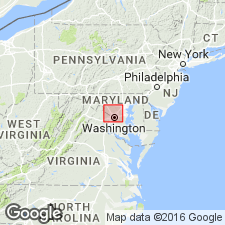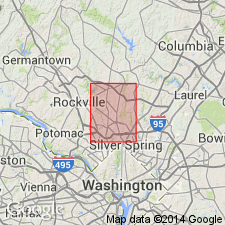
- Usage in publication:
-
- Norbeck Quartz Diorite
- Modifications:
-
- Named
- Dominant lithology:
-
- Diorite
- AAPG geologic province:
-
- Piedmont-Blue Ridge province
Summary:
Named the Norbeck Quartz Diorite for community of Norbeck, Montgomery Co., central MD. Consists of dark quartz diorite that occurs in a pluton in east-central Montgomery Co. Pluton is 8.5 miles long and 1.5 miles wide and trends north. Unit is bounded on north and west by Sykesville Formation and on the south and east by the Wissahickon Formation; Kensington Quartz Diorite impinges on part of its eastern border. The Norbeck is of early Paleozoic age.
Source: GNU records (USGS DDS-6; Reston GNULEX).

- Usage in publication:
-
- Norbeck Intrusive Suite*
- Modifications:
-
- Revised
- Redescribed
- Dominant lithology:
-
- Tonalite
- Diorite
- Gabbro
- AAPG geologic province:
-
- Piedmont-Blue Ridge province
Summary:
The Norbeck is revised to the Norbeck Intrusive Suite which includes tonalite, metadiorite, and gabbro. Three lithologies are mapped in the Kensington quad.: (1) medium- to coarse-grained, fairly massive to foliated biotite-hornblende tonalite that contains xenoliths and(or) autoliths of more mafic rock, (2) medium-grained, quartz-augite-hornblende metagabbro that forms small bodies within the tonalite, and (3) dark-green, well-foliated ultramafic rocks of serpentine and lesser soapstone (appears to be serpentinized pyroxenite). The Norbeck is of Ordovician age.
Source: GNU records (USGS DDS-6; Reston GNULEX).
For more information, please contact Nancy Stamm, Geologic Names Committee Secretary.
Asterisk (*) indicates published by U.S. Geological Survey authors.
"No current usage" (†) implies that a name has been abandoned or has fallen into disuse. Former usage and, if known, replacement name given in parentheses ( ).
Slash (/) indicates name conflicts with nomenclatural guidelines (CSN, 1933; ACSN, 1961, 1970; NACSN, 1983, 2005, 2021). May be explained within brackets ([ ]).

